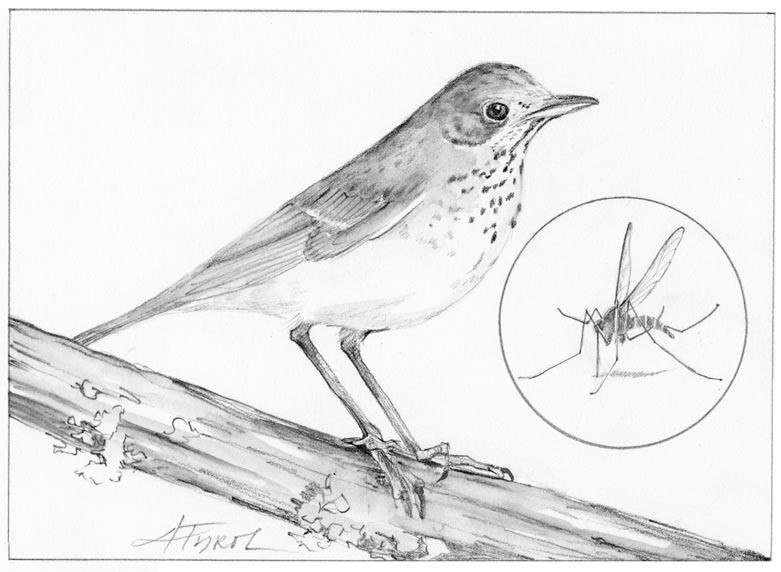
A female mosquito buzzes in the waning light of a late-summer evening. A week ago, she bit a robin at a bird bath, drawing a proboscis full of blood to help create her eggs. The bird’s blood was teeming with West Nile virus, and now the mosquito is loaded with the virus, too.
When this mama mosquito hatched during the summer, she carried little or no West Nile virus. (Scientists aren’t sure if mosquitoes pass the virus to their eggs, but if they do, they don’t pass on much.) But whomever or whatever she bites next will get a dose of West Nile virus, carried in the saliva she injects into her host to keep its blood from clotting while she sips the blood.
Elsewhere, a black-legged tick sits on the very end of a branch a foot or two above the ground at the edge of a forest. Black-legged ticks need a blood meal in both their larval and nymph stages (both are juvenile life stages), and, as youngsters, they dine on the blood of mice, birds, or other small animals. This particular tick found a meal on a white-footed mouse, which passed the bacteria that causes Lyme disease along with its blood.
When the tick reached its adult stage in mid-September, it started to climb. It’s in search of a bigger host than a mouse, and if it climbs high enough and waits, one should brush past. The black-legged tick wants to find a white-tailed deer, which is a singles resort, wedding chapel, and honeymoon cottage all in one. Male and female ticks find each other on the deer, and mate. The tick will take a chance, though, on any warm-blooded creature that brushes against its branch.
Whomever or whatever it bites may get a dose of the Lyme bacteria, too.
Although human occurrences are rare in our area of the world, mosquitoes have the potential to give us West Nile virus, and particularly in New Hampshire, Eastern equine encephalitis. Black-legged ticks have the potential to spread Lyme disease, as well as anaplasmosis and babesiosis, two little-known diseases that are being seen more often in our region.
Even though the Lyme-disease-carrying ticks are on the lookout for large, warm-blooded prey in the fall, it’s spring and summer that are the major seasons for Lyme disease, says Erica Berl, health surveillance epidemiologist for the Vermont Department of Health.
There are several reasons for this, Berl explains. First, tick nymphs are most active in late spring and summer. Tick nymphs are much smaller than the adult ticks you see in fall, and they’re harder to see on your skin. They also transmit the Lyme disease bacteria faster than the adults do.
Still, says Alan Eaton, entomology specialist with the University of New Hampshire Cooperative Extension, you should take precautions against ticks in the fall. In the past he’s reached out to deer hunters, who are out in the woods in autumn and traveling in the same areas as deer, to warn them of the risk of contracting Lyme disease from black-legged ticks, which are also known as deer ticks.
Late summer and early fall are prime time for both West Nile and Eastern Equine Encephalitis. Mosquitoes need to have time to bite a bird infected with the disease and then bite you.
And yes, it is almost always a bird that serves as a reservoir for these two diseases. The viruses just don’t build up to a high enough level in other creatures. Even though horses seem to be the focus of Eastern Equine Encephalitis (EEE), they can’t pass along the disease, either. Like humans, they are merely the victims of it.
“Even though we think of these as human diseases, they are actually bird diseases that are also potentially deadly to us,” says Eaton.
There have been a handful of human EEE cases in New Hampshire, but none in Vermont. In Vermont, Behr says, “We have the right ecological conditions in some areas of the state,” so the Department of Health keeps an eye out for it.
The good news, says Eaton, is that “with the first killing frost, the threat plunges to near zero.” Adult mosquitoes don’t generally survive the winter in our area. It’s a reason to be thankful for our short summers and cold winters.
The possibility of contracting an insect-borne disease in the fall is reason enough to continue taking precautions, like wearing DEET or another insect repellant, wearing pants and long-sleeves when spending time outdoors, and checking for ticks when you return home. Eaton says that EEE is often deadly, and the other insect-borne diseases of the season can be serious, too. “If you do a numbers game, the chance of infection is capital R really low, but the consequences are high.”


Discussion *